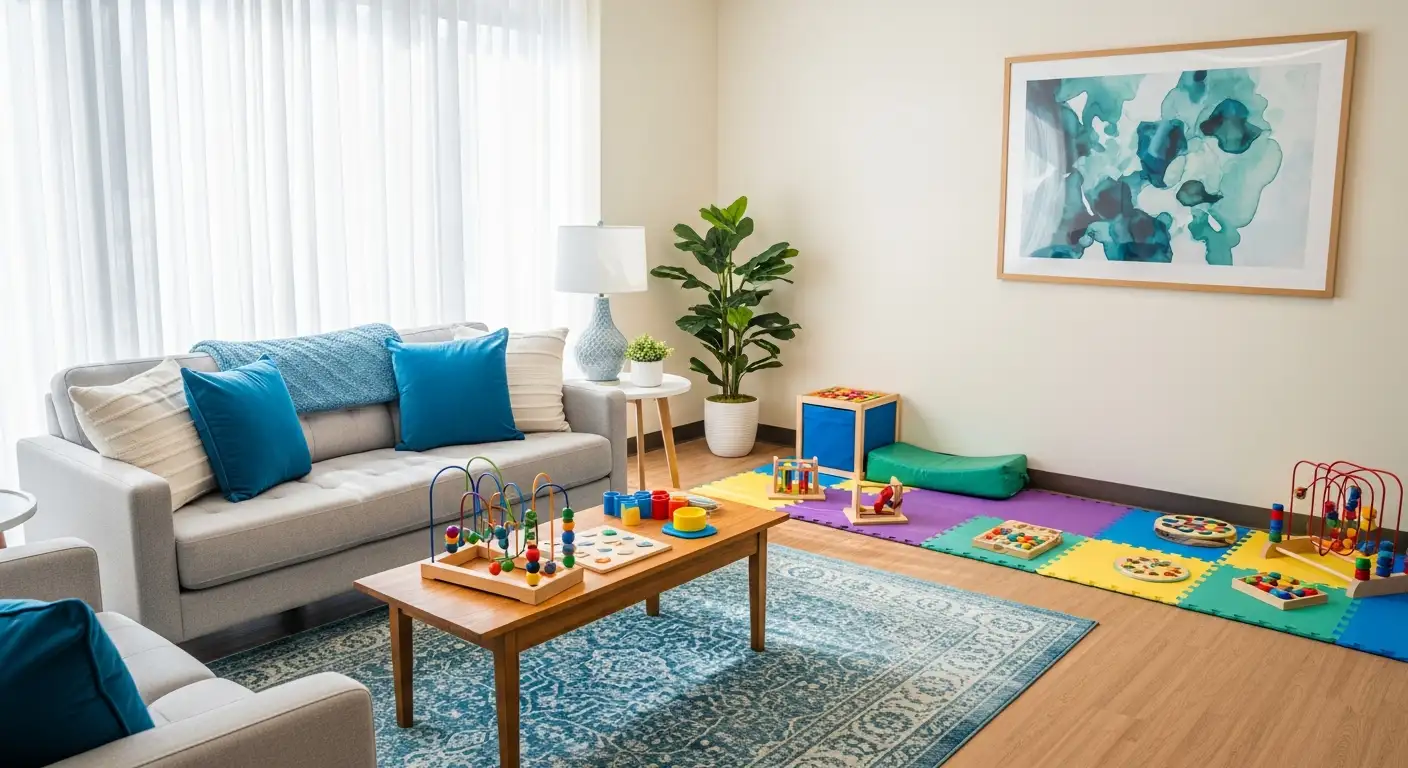Exploring Childhood Anxiety Disorders

Understanding Childhood Anxiety

Childhood anxiety disorders, much like other childhood behavior disorders, can significantly impact a young person's daily life. Understanding the signs and effects of these disorders is the first step toward helping your child navigate and manage their anxiety.
Common Symptoms of Childhood Anxiety
Anxiety disorders in children may manifest in various ways. Common symptoms include fear, worry, irritability, and anger, which can interfere with school, home, or play activities. Physical symptoms such as trouble sleeping, fatigue, headaches, and stomachaches are also common indicators. It is crucial to note that these symptoms must interfere with the child's life for more than six months to be considered a disorder.
As parents, understanding these symptoms can help identify potential anxiety disorders early on and seek the necessary help. Remember, early intervention and treatment are key to managing these conditions effectively.
Impact of Anxiety on Children
Childhood anxiety disorders can have significant long-term impacts. Children with anxiety are at increased risk for depression, substance use disorders, struggling in school, and being at higher risk for suicide. The disorders can also significantly impact their social interactions and home life.
Anxiety disorders are fairly common in children, affecting about 15% to 20% of children and adolescents. Nearly 1 in 3 adolescents between the ages of 13 and 18 has anxiety. The prevalence of these disorders underscores the importance of understanding and addressing childhood anxiety disorders.
Anxiety can be a useful emotion, and it is important for kids with anxiety disorders to learn to differentiate between helpful and unhelpful anxiety. Treatment involves recalibrating anxiety alarms to respond appropriately to dangerous situations.
As we delve into the topic of childhood anxiety disorders, it's important to remember that help is available. Understanding the signs, seeking professional help, and supporting your child through their journey can significantly reduce the impact of anxiety on their lives.
Types of Childhood Anxiety Disorders
Understanding the different types of childhood anxiety disorders can help parents and caregivers identify signs and symptoms early, leading to quicker intervention and better outcomes. Here, we delve into four common types: Generalized Anxiety Disorder (GAD), Separation Anxiety Disorder, Social Phobia (Social Anxiety Disorder), and Panic Disorder.
Generalized Anxiety Disorder (GAD)
Generalized Anxiety Disorder (GAD) is characterized by excessive worry about various things. Children with GAD may worry about daily activities such as homework, tests, recess, and birthday parties, and more abstract concepts like war, weather, or the future. This constant worry makes it hard for them to focus in school and relax, affecting their eating and sleeping patterns.
Additionally, kids with GAD may seek constant approval or reassurance from others, indicating their heightened concern about grades, family issues, relationships with peers, and performance in sports.
Separation Anxiety Disorder

Separation anxiety disorder causes kids to feel very anxious about being apart from their parent or home. This can lead to behaviors such as missing school, clinging to a parent, crying, and having trouble sleeping alone.
This disorder affects about 4 percent of children and is most common in kids aged seven to nine. Symptoms include excessive anxiety away from home or when separated from parents or caregivers, refusal to go to school or camp, and demanding someone stay with them at bedtime.
Social Phobia (Social Anxiety Disorder)
Social phobia, also known as social anxiety disorder, is characterized by an intense fear of social and performance situations. Children with this disorder are often too afraid of what others will think or say, leading to extreme fear in situations like class presentations or group activities with classmates. This can cause them to avoid school or friends [5].
This disorder can significantly impair a child's school performance, attendance, ability to socialize with peers, and develop relationships [6].
Panic Disorder
Panic disorder can cause sudden anxiety attacks with overwhelming physical symptoms such as feeling shaky, trembling, a racing heart rate, and shortness of breath. These attacks can happen at any time and are more common in teens than in kids [5].
The understanding and recognition of these disorders are the first steps towards helping a child manage their anxiety. Parents and caregivers can look for signs and seek professional help when needed. Learn more about other childhood behavior disorders, childhood learning disorders, childhood eating disorders, and childhood speech disorders to get a broader understanding of the challenges children may face.
Treatment Options for Childhood Anxiety
Addressing childhood anxiety disorders involves a multi-faceted approach. Here, we explore three primary treatment options: Cognitive-Behavioral Therapy (CBT), medication, and a combined approach of CBT and medication.
Cognitive-Behavioral Therapy (CBT)
Cognitive-behavioral therapy (CBT) is a scientifically proven and effective treatment for anxiety disorders in children. CBT teaches children to identify and replace negative thinking patterns and behaviors with positive ones. Sessions typically last about 12 weeks and provide long-term benefits [7]. However, only about half of the children respond to this therapy.
CBT equips children with the skills to cope with worries and emotions healthily. It is considered the most effective treatment for anxiety disorders in children, but it's crucial to remember that each child is unique, and what works for one may not work for another.
Medication Therapy
Medications like Selective Serotonin Reuptake Inhibitors (SSRIs) and Serotonin and Norepinephrine Reuptake Inhibitors (SNRIs) can be prescribed to treat childhood anxiety. These medications may take some time to start working, and if one medication is not effective, another may be tried.
The FDA has approved some SSRIs for pediatric obsessive-compulsive disorder. Other types of medications like tricyclic antidepressants and benzodiazepines are less commonly used for children.
Combined Approach: CBT and Medication
A combination of cognitive-behavioral therapy (CBT) and an antidepressant has been found to work better for children aged 7-17 with anxiety disorders than either treatment alone, according to a major research study [7].
Both treatments may work on their own, but they seem to work better together [2]. This combined approach can provide a comprehensive treatment plan for children dealing with anxiety disorders.
Remember, the most effective treatment varies from child to child. It's essential to work closely with healthcare professionals to determine the best course of action. For more information on other childhood disorders, you can explore our articles on childhood behavior disorders, childhood learning disorders, childhood eating disorders, and childhood speech disorders.
Specific Childhood Anxiety Disorders

While there are many forms of anxiety disorders that can affect children, this section will focus on three specific ones: Selective Mutism, Posttraumatic Stress Disorder (PTSD), and Specific Phobias.
Selective Mutism
Selective Mutism is a complex childhood anxiety disorder where children consistently refuse to speak in certain situations where talking is expected or necessary, such as at school or in public places. Despite this, these children may display normal verbal communication in comfortable environments, like at home. This refusal can interfere with their academic performance and their ability to make friends, leading to significant distress.
The signs of Selective Mutism usually become evident when children start school. It's essential to understand that children with Selective Mutism are not choosing not to speak out of defiance or shyness. It's an actual anxiety disorder that requires professional treatment.
Posttraumatic Stress Disorder (PTSD)
Posttraumatic Stress Disorder (PTSD) can develop in children who have experienced or witnessed a traumatic event. The symptoms may include intense fear, anxiety, emotional numbness, irritability, or avoidance of places, people, or activities associated with the traumatic event. Importantly, not every child exposed to trauma will develop PTSD.
PTSD in children can manifest itself in a variety of ways. Some children may re-enact the traumatic event through their play, while others may have nightmares or intrusive thoughts about the event. These symptoms can be distressing and can significantly impact a child's daily life.
Specific Phobias
Specific Phobias in children are characterized by an extreme, intense, and long-lasting fear of specific things or situations. The fear is disproportionate to the actual danger posed by the feared object or situation. Children with specific phobias will go to great lengths to avoid encountering what they're afraid of, which can lead to significant distress and difficulty in calming down.
Common examples of specific phobias in children include fear of animals, heights, thunderstorms, or medical procedures. It's important to recognize that for a fear to be considered a phobia, it must interfere with the child's daily life or cause significant distress.
Childhood anxiety disorders, such as Selective Mutism, PTSD, and Specific Phobias, can have a significant impact on a child's life, affecting their school performance, social interactions, and overall well-being. However, with the right support and treatment, children can learn to manage their anxiety and lead fulfilling lives. For more information about other childhood disorders, check out our articles on childhood behavior disorders, childhood learning disorders, childhood eating disorders, and childhood speech disorders.
Diagnosis and Management
In the realm of childhood anxiety disorders, timely diagnosis and effective management are crucial. Understanding the screening and diagnosis process, as well as developing therapy plans, can greatly assist parents in caring for children with these disorders.
Screening and Diagnosis Process
The United States Preventive Services Taskforce recommends screening for anxiety in children and adolescents. This is a vital step in identifying children who may be struggling with anxiety, even if they don't outwardly exhibit classic symptoms.
Depression screening is also recommended for adolescents. It's important to note that some children with depression may not exhibit sadness outwardly and could be mislabeled as trouble-makers or lazy.
The diagnosis process typically involves consultation with healthcare providers to discuss concerns and symptoms. It's also common to use questionnaires or checklists to gather information about the child's behavior and feelings. In some cases, further evaluation from a mental health professional may be necessary.
Developing Therapy Plans
Once a diagnosis of an anxiety disorder has been made, developing a therapy plan is the next crucial step. According to the CDC, treatment for anxiety and depression in children involves developing therapy plans which may include cognitive-behavioral therapy, family therapy, and behavior therapy to help children manage symptoms and learn coping strategies.
Cognitive-behavioral therapy (CBT) is the most common treatment for anxiety disorders in children and teens. This form of therapy helps them manage worry, fear, and anxiety by teaching them that facing fears weakens them and helps them feel better.
Studies have shown that a combination of cognitive-behavioral therapy (CBT) and an antidepressant has been found to work better for children aged 7-17 with anxiety disorders than either treatment alone.
Furthermore, researchers randomly assigned 124 children, aged 7 to 14, diagnosed with an anxiety disorder to either standard cognitive behavioral therapy or the SPACE program. Both treatments, consisting of 12 weekly 60-minute sessions, reduced the children's level of anxiety and anxiety-related emotional disorders to a similar degree.
These therapy plans, often developed in collaboration with a mental health professional, can provide children with the tools they need to manage their anxiety and live a healthier, happier life. It's also important to note that parents' involvement in their child's treatment can help reduce anxiety.
In conclusion, understanding the processes of diagnosing and managing childhood anxiety disorders can greatly assist in the overall well-being of children. By being proactive and taking an active role in their child's mental health, parents can facilitate effective treatment and foster a more supportive environment for their child.
Supportive Parenting for Childhood Anxiety
When navigating childhood anxiety disorders, parents play an instrumental role. Their involvement in treatment and day-to-day strategies can make a significant impact on their child's ability to manage anxiety.
Role of Parents in Treatment
Studies have shown that a parent's active involvement in their child's treatment can help reduce anxiety [3]. Parents can assist by identifying accommodating behaviors to reduce and teaching new ways to respond to their child's anxiety.
A program called Supportive Parenting for Anxious Childhood Emotions (SPACE) was tested to determine if teaching parents strategies for responding to their child's anxiety works as well as cognitive behavioral therapy. Remarkably, results showed that both approaches work equally well to reduce childhood anxiety. The study included 124 children aged 7 to 14 diagnosed with an anxiety disorder, who were randomly assigned to either standard cognitive behavioral therapy or the SPACE program. Both treatments, consisting of 12 weekly 60-minute sessions, reduced the children's level of anxiety and anxiety-related emotional disorders to a similar degree.
Supportive Parenting Strategies
- Distinguish Between Helpful and Unhelpful Anxiety: Anxiety can be a useful emotion, and it is important for kids with anxiety disorders to learn to differentiate between helpful and unhelpful anxiety. Treatment involves recalibrating anxiety alarms to respond appropriately to dangerous situations.
- Avoid Avoidance: Helping children avoid things they fear may provide short-term relief but reinforces anxiety in the long run. It is crucial to send the message that children are brave enough to handle scary situations, even if they feel anxious.
- Express Positive and Realistic Expectations: Parents should not promise that a child's fear won't happen, but should express confidence that the child will be able to manage whatever happens, helping them tolerate uncertainty [4].
- Validate Feelings Without Empowering Them: It's essential to acknowledge the child's fear but also inspire confidence in their ability to be brave in facing their fears.
- Encourage and Acknowledge Effort: Encouraging children and acknowledging their hard work in facing their fears can be beneficial. Reminding them that the more they tolerate their anxiety, the more it will diminish can help in the process.
Parents can make a significant difference in their child's journey through childhood anxiety disorders. Along with professional help, understanding and implementing these strategies can provide a supportive environment for children to manage their anxiety. For more information on other childhood disorders, please visit our pages on childhood behavior disorders, childhood learning disorders, childhood eating disorders, and childhood speech disorders.
References
[2]: https://my.clevelandclinic.org/health/diseases/anxiety-in-children
[3]: https://www.nih.gov/news-events/nih-research-matters/supportive-parenting-can-reduce-childs-anxiety
[4]: https://childmind.org/article/10-tips-for-parenting-anxious-kids/
[5]: https://kidshealth.org/en/parents/anxiety-disorders.html
[6]: https://adaa.org/find-help/by-demographics/children/childhood-anxiety-disorders
[7]: https://adaa.org/living-with-anxiety/children/treatment
Recent articles

ABA Therapy Strategies To Reduce Tantrums In Public Settings
Effective ABA Techniques to Manage Public Tantrums in Children with Autism

ABA Therapy Strategies For Supporting Academic Perseverance
Unlocking Potential: How ABA Therapy Fuels Academic Perseverance in Children with Autism

ABA Therapy For Teaching Long-Term Planning And Goal Achievement
Unlocking Future Success: How ABA Therapy Shapes Long-Term Planning and Goal Achievement in Autism

How ABA Therapy Helps With Following Community Safety Rules
Enhancing Safety and Independence: The Role of ABA Therapy in Community Rule Compliance

How ABA Therapy Improves Behavior In Inclusive Classrooms
Transforming Inclusive Education: The Role of ABA Therapy in Behavior and Skill Development

Teaching Personal Hygiene Routines Through ABA Therapy
Empowering Independence: How ABA Therapy Transforms Hygiene Skills in Children with Autism



